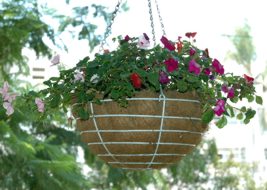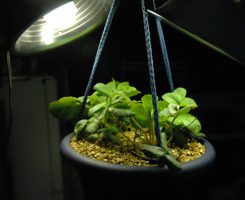July 20, 2005
Love of Horticulture Part 2
One of my early blogs (mid-June last year) I wrote at some length about my little porch and houseplant projects. At that time I was gearing up for a trip to London (as I am again today) and I posted pictures of my little babies.
 Among other things was "the plant that would not die" that was a carry-over from the previous owner. After I pretty much tried to kill the plant with neglect, I decided it deserved to live and have been watering it. The thing is several feet taller (can now look over the balcony with standing on anything!) and doing rather well. There are some other similar-looking plants (but certainly different species) that are growing as well. I have no idea how they got in that pot, but I just keep giving it water and it keeps growing!
Among other things was "the plant that would not die" that was a carry-over from the previous owner. After I pretty much tried to kill the plant with neglect, I decided it deserved to live and have been watering it. The thing is several feet taller (can now look over the balcony with standing on anything!) and doing rather well. There are some other similar-looking plants (but certainly different species) that are growing as well. I have no idea how they got in that pot, but I just keep giving it water and it keeps growing!
One of my ferns is turning out to be seriously gorgeous! I put it in one of those "self-watering pots" that has a water reservoir in the bottom—it uses wicks to pull the moisture up into the soil—and it is doing incredibly well. (The second fern needs to find a hook. I think the act of gently twisting around in the wind has allowed my "prize" fern to become perfectly symmetrical. Anyway, they are doing well.
 The Impatiens have been interesting. These are colorful flowers that are supposed to be annuals, but in a climate like Los Angeles that never frosts, they can keep growing. The problem is that the stems get long and funky and they start looking like big mutant octopi! But I found that seriously pruning them back, the foliage comes back perfectly healthy. A hanging basket of Impatiens is, I think, one of the nicest things you can have on a balcony.
The Impatiens have been interesting. These are colorful flowers that are supposed to be annuals, but in a climate like Los Angeles that never frosts, they can keep growing. The problem is that the stems get long and funky and they start looking like big mutant octopi! But I found that seriously pruning them back, the foliage comes back perfectly healthy. A hanging basket of Impatiens is, I think, one of the nicest things you can have on a balcony.
Finally, I've got the great experiment: Hydroponic Strawberries. Since I was a kid I was fascinated by the field of hydroponics (growing plants without dirt) and at times I've tinkered around with it. One of the advantages to hydroponics is that once you get everything established, it can be relatively low-maintenance. Some hydroponic kits can store water in a reservoir and gradually feed plants over a week or longer!
As I wrote in my earlier blog, my apartment gets almost no direct sunlight. It's in fact a rather dark place. Some may like the subterranean feel; I do not. I've been brewing in the back of my mind the concept of marrying indoor hydroponic houseplants and indoor lighting that would both supplement the plants' light needs and brighten up the apartment. Ultimately, I think it would be cool to design large sculpture-like pieces of furniture that held some plants, fed them automatically (so one could go on business trips for over a week without needing a plant-sitter) and had built-in lighting that would feature them and brighten the overall room.
 Okay, I suspect such a project would be incredibly geeky, but why not? I don't know why, but I also become interested a few months back in strawberries. They're an interesting plant because they can multiply easily if you just plant the runners. I've also heard they respond well to hydroponics, and it just seemed that if I were to experiment with some thriving indoor plant, why not one that would yield a constant crop of strawberries year-round?
Okay, I suspect such a project would be incredibly geeky, but why not? I don't know why, but I also become interested a few months back in strawberries. They're an interesting plant because they can multiply easily if you just plant the runners. I've also heard they respond well to hydroponics, and it just seemed that if I were to experiment with some thriving indoor plant, why not one that would yield a constant crop of strawberries year-round?
So I bought a Strawberry plant that was already planted in a hanging basket. I then clamped two cheap $5 shop lamps to the top of the basket, fitted them with those funky new high-efficiency fluorescent bulb fixtures (excellent because they give off a lot of light for much fewer watts than standard bulbs and don't put off hardly any heat!) and plugged them into a timer that would give the plant 16+ hours of good strong light per day.
Note that none of this (yet) has to do with hydroponics. My intention was to root the 2 runners and start them out baby hydroponic strawberries!
I'll write a little bit tomorrow about that project. This blog is already getting a bit long.
Posted by Murray Todd Williams at July 20, 2005 04:15 PMHi Murray:
Noticed on an earlier blog that you could grow african violets from clippings. I have tried and failed miserably. In fact I killed about three actual plants. I have one that is flourishing and another that is slowly dieing. I would like to able to take clippings on the healthy , but how?
Any advice would be helpful. Thanks
Camille
It's hard to give advise without seeing the plants and getting a gut feeling about them. For my own growing of clippings, I really just stuck the end of a clipping (a single leaf with as long a stem as possible) in some soil and made sure to keep the soil moist for the first 2-3 weeks.
I can't speak on African Violets specifically, but generally I've found that the success in nurturing plants to life is a combination of (a) soil (b) moisture level and (c) light. Now that's an incredibly vague statement, but what I mean is that it takes monitoring and experimentation, and it's rarely intuitive. I tried spouting some seeds of typical herbs (basil, oregano, etc.) and spent a lot of time sterilizing some soil, placing it in a spouter, tamping it down, adding seeds, etc. and what resulted were these dead-looking anemic things. Then I took some peat pellets and quickly (without nearly as much attention) popped some seeds in and added water every couple days and the things exploded with sprouts.
Actually, I'd recommend the peat pellet for your African Violet cuttings. It'll hold ample moisture, and when you start seeing little roots penetrating from the pellet, immediately transplant into a pot with some light soil mix (nothing that gets to boggy when watered—if so add some vermiculite or peat moss) and then only water once a week or whenever you notice the soil is getting really dry. Generally what I'm trying to say is that although the cuttings need to be kept constantly moist until they can develop roots, nothing kills a plant like over-watering!
Regarding light: I recommend finding the place that has the most indirect sunlight (not a sunny windowsill! No direct light at first!) and slowly move a plant into brighter and brighter conditions as long as it still looks healthy.
Finally, I'd say don't panic if a few plants die. That's the way it just turns out. Try altering the variables a lot. Look into having on hand a few bags of different types and consistencies of topsoil. It won't take long until you get the combination right and you have huge incredible plants.
For whatever that advise is worth...
Murray
Posted by: Murray Todd Williams at August 21, 2005 08:42 AM